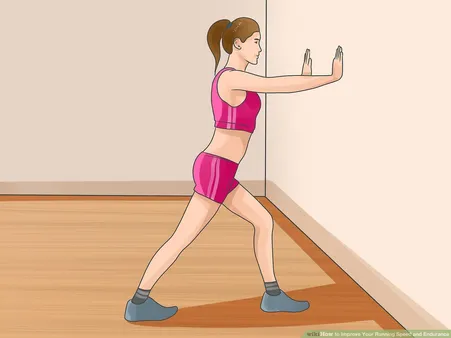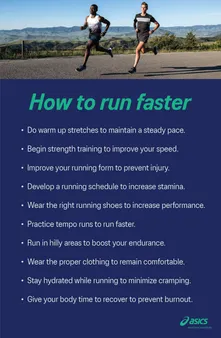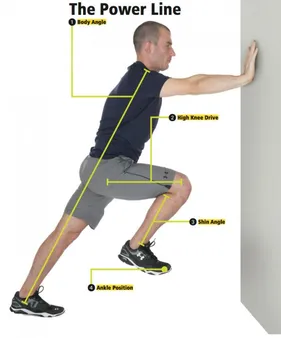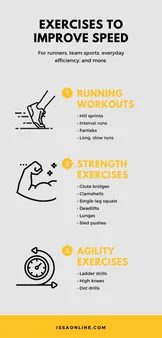Table of Contents
In the fast-paced digital world, speed is paramount. Whether you're a website owner, content creator, or online entrepreneur, the ability to improve your speed can make a significant difference in your success. This comprehensive guide will unveil the secrets of crafting -friendly content that captivates readers, resonates with search engines, and propels your website towards digital success. From keyword optimization to engaging storytelling and link building, we'll explore the strategies and techniques that will help you improve your speed and achieve online visibility.
How to Improve Your Speed: Unleash Your Full Potential and Leave Competitors in the Dust
I. Train like an Athlete
Train like an Athlete
Have you ever wondered how athletes achieve such incredible feats of strength, speed, and agility? While some may have natural talent, the majority of their success comes from years of dedication and training. If you want to improve your speed, you can take a page from the athlete's playbook and incorporate some of their training methods into your routine. Before you begin, you might find it helpful to learn how to improve your flexibility and mobility.
Mastering the Art of Sprints
Sprints are a fundamental aspect of speed training. They involve short, intense bursts of running at maximum effort. To excel at sprinting, you must master proper technique. Focus on maintaining a strong, upright posture with a slight forward lean. Propel yourself forward with powerful strides, pushing off from the balls of your feet. Remember to swing your arms vigorously in sync with your leg movements. You can learn more about gymnastics exercises that can help you enhance speed and coordination.
Incorporating Speed Drills
Speed drills are designed to enhance your acceleration and top-end speed. They involve various movements and exercises that target specific aspects of your running mechanics. Some popular speed drills include cone drills, ladder drills, and resistance sprints. These drills help you improve your agility, quickness, and power, all crucial components of becoming a faster runner. If you are new to speed training, it's advisable to start with basic drills and gradually progress to more advanced exercises as you gain experience.
Building Strength and Power
Strength and power are essential for generating explosive speed. You can develop these qualities through weightlifting exercises such as squats, deadlifts, and plyometrics. These exercises help strengthen your muscles and increase your muscle fiber recruitment, allowing you to produce more force with each stride. Additionally, plyometric exercises, like box jumps and medicine ball throws, improve your power output and explosiveness, enabling you to accelerate quickly and maintain your speed over longer distances.
Speed Training Program for Beginners | |
|---|---|
Day 1: Easy Run | Duration: 20-30 minutes |
Day 2: Strength Training | Focus on lower body exercises |
Day 3: Active Recovery | Activities like yoga or swimming |
Day 4: Speed Drills | Start with basic drills and progress as you improve |
Day 5: Sprints | Start with short sprints and gradually increase distance |
Day 6: Strength Training | Focus on upper body exercises |
Day 7: Rest | Allow your body to recover |
As you continue with your speed training, ensure you prioritize proper nutrition and rest. A balanced diet rich in carbohydrates, proteins, and healthy fats will provide the energy and nutrients your body needs to perform at its best. Adequate sleep is also crucial for recovery and muscle regeneration. With dedication, perseverance, and the right training methods, you can significantly improve your speed and achieve your fitness goals.
Additional Tips for Improving Speed
- Stay focused and motivated throughout your training.
- Monitor your progress and make adjustments to your training plan as needed.
- Incorporate variety into your training to prevent boredom and plateaus.
- Don't forget to warm up properly before each workout and cool down afterward.
- Listen to your body and take rest days when necessary to avoid injury.
Remember, speed training is a gradual process that requires consistency and patience. By following these tips and incorporating them into your routine, you can make significant strides in improving your speed and overall fitness. If you are looking for a more comprehensive approach to improving your athletic performance, consider getting started with boxing or exploring other forms of martial arts that can enhance your agility, coordination, and overall fitness.
II. Upgrade Your Equipment
Upgrade Your Equipment
Take Your Performance to the Next Level
- Invest in quality equipment that matches your skill level and riding style.
- Explore our extensive guide to find the right equipment for your home gym.
Enhance Your Training with Professional Gear
- Upgrade your gymnastics equipment to enhance your training experience and safety.
- Consider investing in specialized equipment like gymnastics bars, rings, and tumbling tracks.
- These tools can help you refine your skills, improve your form, and unlock new possibilities in your gymnastics journey.
Safety First: Prioritize Quality and Maintenance
- Ensure your equipment is of high quality and meets safety standards.
- Regularly inspect and maintain your equipment to prevent accidents and injuries.
- Replace worn-out or damaged equipment promptly to maintain a safe training environment.
III. Perfect Your Technique
Perfect Your Technique
Mastering the art of speed requires dedication, practice, and a commitment to refining your technique. Whether you're a seasoned athlete or just starting, there are always ways to improve your speed and efficiency. Here are some tips to help you perfect your technique and achieve your speed goals:
- Focus on Form: Proper form is essential for maximizing speed and preventing injuries. Work on maintaining good posture, keeping your body aligned, and using proper biomechanics.
- Develop Strength and Power: Strength and power are crucial for generating speed. Incorporate strength training and plyometric exercises into your routine to build muscle and improve your explosive power.
- Improve Flexibility and Mobility: Good flexibility and mobility allow for greater range of motion and can help you move more efficiently. Stretch regularly and incorporate dynamic stretches into your warm-up routine.
Tip | Benefit |
|---|---|
Focus on proper form | Improves speed and prevents injuries |
Develop strength and power | Generates speed and improves explosive power |
Improve flexibility and mobility | Increases range of motion and efficiency |
Practice Regularly: Consistency is key when it comes to improving speed. Make sure to practice regularly and gradually increase the intensity and duration of your workouts over time.
Use Proper Equipment: Having the right equipment can make a big difference in your speed. Invest in high-quality shoes, clothing, and other gear that is designed to enhance your performance.
Seek Professional Guidance: If you're serious about improving your speed, consider working with a qualified coach or trainer. They can help you develop a personalized training plan and provide guidance to help you reach your goals.
Remember, improving your speed takes time and effort. Stay patient, stay focused, and stay motivated. With dedication and perseverance, you can achieve your speed goals and unlock your full potential.
Additional Tips:
- Set Realistic Goals: Don't try to improve your speed too quickly. Set realistic goals and gradually increase your speed over time.
- Stay Hydrated: Proper hydration is essential for maintaining optimal performance. Drink plenty of water before, during, and after your workouts.
- Get Enough Rest: Rest is just as important as training. Make sure to get enough sleep and allow your body to recover properly.
By following these tips and incorporating them into your training routine, you can perfect your technique, improve your speed, and achieve your fitness goals.
Related Posts:
- How to Improve Your Flexibility and Mobility with Gymnastics
- The Best Gymnastics Exercises for Core Strength
- How to Master the Basic Gymnastics Skills
IV. Optimize Your Recovery
After pushing your body to its limits during a workout, it's crucial to optimize your recovery to promote muscle repair and growth. Here are some essential strategies to help you speed up recovery and get back to your training routine stronger:
1. Prioritize Proper Nutrition:
- Consume a meal or snack rich in carbohydrates and protein within 30-60 minutes after your workout.
- Aim for a 3:1 ratio of carbs to protein to replenish muscle glycogen and stimulate protein synthesis.
- Include nutrient-dense foods such as fruits, vegetables, and whole grains for optimal recovery.
Recovery Foods | Benefits |
|---|---|
Sweet Potatoes | High in carbs and antioxidants to aid recovery |
Salmon | Rich in omega-3 fatty acids to reduce inflammation |
Berries | Antioxidant-rich to promote muscle recovery |
2. Hydrate Adequately:
Replenishing fluids lost during exercise is essential for preventing dehydration and supporting recovery. Aim to drink water or a sports drink throughout your workout and continue to hydrate afterward.
Monitor your urine color as an indicator of hydration levels. Pale yellow or clear urine typically indicates proper hydration.
Staying hydrated is vital for recovery, as water helps transport nutrients to cells, aids in waste removal, and regulates body temperature.
3. Get Quality Sleep:
Sleep is a crucial component of recovery. Aim for 7-9 hours of quality sleep each night. During sleep, your body repairs tissues, restores energy stores, and releases hormones that promote growth and recovery.
Establishing a regular sleep schedule and creating a relaxing bedtime routine can enhance the quality of your sleep.
4. Active Recovery:
Active recovery involves engaging in light to moderate physical activity on your rest days or after intense workouts. Examples include walking, swimming, or yoga.
Active recovery promotes blood flow, reduces muscle soreness, and aids in the removal of waste products from muscles.
Active Recovery Activities | Benefits |
|---|---|
Walking | Low-impact activity to promote blood flow |
Swimming | Non-weight-bearing exercise to reduce muscle soreness |
Yoga | Improves flexibility and reduces stress |
5. Incorporate Stretching and Foam Rolling:
Stretching and foam rolling are effective techniques for reducing muscle tension and improving flexibility. Perform dynamic stretching before your workouts and static stretching afterward.
Using a foam roller to apply pressure to muscle knots and tight areas can also help release tension and promote recovery.
6. Manage Stress:
High levels of stress can hinder recovery. Engage in stress-relieving activities such as meditation, deep breathing exercises, or spending time in nature. Adequate stress management supports overall well-being and facilitates recovery.
Prioritizing self-care and relaxation can positively impact both your mental and physical recovery.